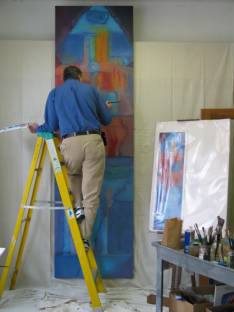
Artist's Statement About Recent Work
In the summer of 2000 I left a successful 20-year career
in marketing to become a full-time artist, a dream since high school.
I left behind the security - both financial and psychological - of having
a place in an established, respected organization to begin to build a
significant body of work and reputation as an artist. Art is that important
to me. It is more than a full-time endeavor. Every day I feel a sense
of urgency to make progress.
I'm a painter because I have a passion to express intuitive
feelings about color. I believe that painting is alive and well and there
is much more to be said through painting. My work is abstract because
I want to create new images rather than render images from nature. I want
each painting to be a new experience for the viewer. I want each piece
to be open to the viewer's personal interpretation and elicit each viewer's
unique experiences and emotions.
Ironically, I found that the shortest route to a personal,
contemporary abstract vision was through ancient Egypt. The longest series
of paintings I've created has been inspired by the divisions of space
and color palettes used thousands of years ago in Egyptian funerary architecture
and objects. I call this series Luminous Egypt because the luminosity,
depth and complexity of color and the historical origination of the imagery.
I am intrigued that over millennia men have been compelled to decorate
surfaces and divide space in ways that recur again and again. Every painting
is also informed to some extent by painters
who have come before me and by the relentless stream of visuals in
our popular culture.
As I've developed this series I've researched
and sketched artifacts from ancient cultures now in museums such as:
the Metropolitan Museum of Art in New York; the Museum of Man in San Diego;
the Brooklyn Museum (showing Eternal Egypt, Masterworks of Ancient Art
from the British Museum); the Louvre in Paris; the Field Museum in Chicago
(showing the Cleopatra exhibition); and the Museum of Archeology and Anthropology
at the University of Pennsylvania in Philadelphia. This series includes
the Stele, Stela, Temple, and Passage paintings as well as other titles
like Stele Avec Scéne Banquet and Architectural Slab of Nectanebo 1 (back).
The process of painting is extremely important to me.
When I first learned to paint in the early 70's I concentrated on controlling
the media. It wasn't until I was confident enough to give up complete
control and let the materials and process create accidents that my work
became truly exciting to me. Because the accidents were beyond the scope
of my imagination, the work became better than I could conceive.
In the future I plan to continue to explore new abstract
compositions with historical origins. I plan to continue to work on both
small-scale and large-scale paintings. The smaller pieces provide opportunities
for personal, intimate viewing. Because the large-scale pieces require
a larger space they offer opportunities to experience each piece in a
different way from various distances. I plan to create more
large-scale work that is intended to be seen as a group rather than
each piece individually.
Thomas C. Jackson
|
